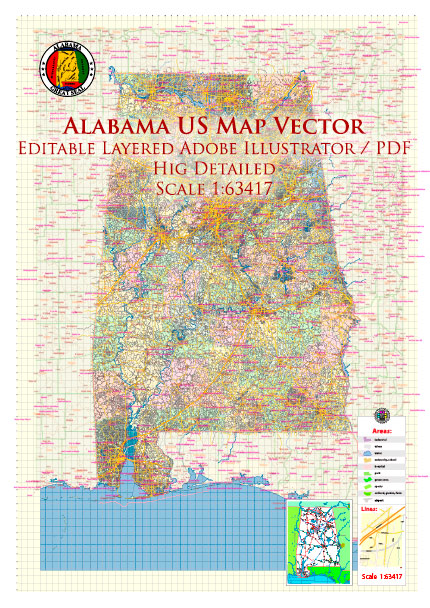Population & Major Metropolitan Areas
Alabama has 13 Metropolitan Statistical Areas that serve as home to prospering businesses,
prestigious colleges and universities, nationally-renowned health centers and doctors,
and an affordable housing market. There’s a reason why Alabama hospitality is legendary
and our quality of life cannot be beaten.
As the 23rd-most populous state in the U.S., we’re proud that 20 million people from across
the world visit our state every year. But our lifeblood is our citizens—a culturally diverse
group that knows how to get the job done when it’s time to work and enjoys life to the
fullest when it’s time to relax.
Geography
Alabama boasts a geography that spans all different sorts—one of the most varied in the nation, in fact.
From mountains and valleys to beaches and riverbanks, there’s a wealth of
natural beauty on display when you need to get away.
Total Area – 52,424 square miles
Highest point – 2,407 feet above sea level (Mt. Cheaha)
35,469 square miles of forest (71%)
1,776 square miles of water
53 miles of coastline
1,350 miles of navigable waterways
Accessible minerals – limestone, salt, quartz, and iron ore
Accessibility
Alabama sits at the heart of the fastest growing region in the United States.
Comprised by a network of thousands of roads, plentiful airports, inland waterways,
and proximity to the 9th largest seaport in the U.S.,
Alabama is as easy to access as it is a choice for businesses.
6 Interstates – Totaling 1,126 miles
4 Class 1 Railroads totaling more than 2,500 miles of rail
90 Public Airports
19 U.S. Highways totaling 3,852.85 miles
9th largest deepwater seaport in U.S.—Port of Mobile
5 cargo airports
A general overview of the economic and industrial landscape of Alabama.
Vectormap.Net provide you with the most accurate and up-to-date vector maps in Adobe Illustrator, PDF and other formats, designed for editing and printing. Please read the vector map descriptions carefully.
Economy: Alabama has a diverse and robust economy with key sectors contributing to its overall economic growth. Some of the significant aspects include:
- Manufacturing: Alabama has a strong manufacturing base, particularly in the automotive and aerospace industries. The state is home to major automotive manufacturing plants, including those operated by Mercedes-Benz, Honda, and Hyundai. The aerospace industry also plays a vital role, with companies like Boeing and Airbus having a presence.
- Agriculture: Agriculture has traditionally been an essential component of Alabama’s economy. The state produces a variety of crops, including poultry, cotton, soybeans, corn, and peanuts. Livestock farming, especially poultry farming, is a significant contributor to the state’s agricultural output.
- Natural Resources: Alabama is rich in natural resources, including coal, natural gas, timber, and minerals. The state has historically been a major player in the coal industry, although the demand for coal has fluctuated in recent years.
- Services and Finance: The service sector, including finance, healthcare, and education, is a growing part of Alabama’s economy. Birmingham, the largest city in the state, serves as a financial hub, with a notable presence of banking and finance institutions.
- Tourism: Alabama’s scenic landscapes, historical sites, and cultural attractions contribute to a thriving tourism industry. The Gulf Coast, with its beautiful beaches, and historical sites like Montgomery and Birmingham, attract visitors from within and outside the state.
Industrial Overview: Alabama’s industrial landscape is characterized by a mix of traditional industries and modern sectors. Some key industrial aspects include:
- Automotive Industry: Alabama has become a major player in the automotive manufacturing sector. The state is home to multiple automobile and parts manufacturing plants, contributing significantly to employment and economic output.
- Aerospace and Defense: The aerospace and defense industries have a substantial presence in Alabama, with companies engaged in aircraft manufacturing, aerospace engineering, and defense contracting.
- Steel Production: Alabama has a long history of steel production, and the industry continues to be a key player in the state’s economy. Cities like Birmingham have been historically associated with steel manufacturing.
- Chemical and Manufacturing: The chemical industry, including the production of chemicals, plastics, and rubber, is a vital component of Alabama’s manufacturing sector.
It’s important to note that economic conditions can change, and new developments may have occurred since my last update. For the most current and detailed information, it’s recommended to refer to recent economic reports, government publications, and industry analyses specific to Alabama.


 Author: Kirill Shrayber, Ph.D.
Author: Kirill Shrayber, Ph.D.